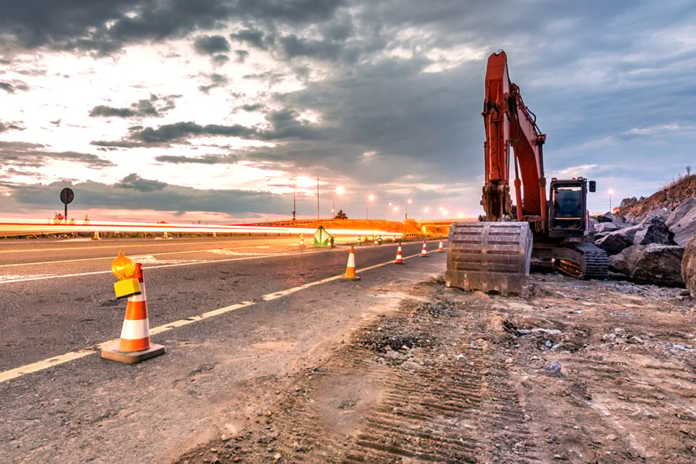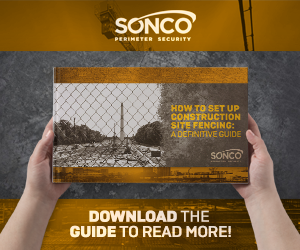All construction sites have their potential dangers, but a road construction site is particularly testy. It’s one thing to ensure your workers stay safe, it’s another to have to worry about drivers.
Thankfully, there are many ways to maximize safety and security. From choosing the right equipment to putting an emphasis on communication, best practice is a lot more approachable than one might think.
Here are ten tips courtesy of a Sonco expert. For more personalized advice specific to your site, don’t hesitate to reach out to our team for no-obligation insight.
- 1 1. Make Things As Easy As Possible for Drivers
- 2 2. Install Lights and Reflective Tape
- 3 3. Provide Workers with Unhindered Visibility
- 4 4. Replace Concrete Barriers Where They’re Unnecessary
- 5 5. Create a Custom Safety Program
- 6 6. Consider Optimizing Your OSHA Signage
- 7 7. Take Special Care in Separating Work Areas
- 8 8. Fence Toppers and Screens Can Go A Long Way
- 9 9. PPE Includes High-Vis Clothing and Ear Protection
- 10 10. Early Warning Areas and Encouraging Communication
1. Make Things As Easy As Possible for Drivers
The more a driver needs to think, the more likely they are to cause an accident. Take all the guesswork out of it by creating clear cut lanes that eliminate any confusion.
It’s not possible for cones to be too close together if you have a surplus. But based on what you have, the closer together you can make them, the better. Further, cones are best for slow moving traffic and straightaways.
Channelizer drums can feature heavy-duty bases that ensure they’re not blown over. They also have more surface area in general and for reflective tape. And while cones can feature light toppers, lights are normally reserved for drums and Jersey barriers.
For tight turns and high-speed traffic, Jersey style barriers are going to be essential. And while the bright orange plastic water barriers may have excellent visibility, you’ll likely need cement per FHWA and local regulations.
The goal is always to protect your crew from any potential accidents from drivers. But you also want to make sure the driver is in the best position to avoid making any mistakes. People can panic easily behind the wheel, so you want them to be totally confident in the direction they’re going and the speed they need to maintain.
2. Install Lights and Reflective Tape
Even in the most arid climates, you’ll want reflective tape on all possible equipment in case of overcast days. Even if all work is done in the daytime, rain and fog are common weather that can make reflective tape downright essential.
For nighttime work and leaving equipment overnight, you’ll likely want to install some lights on your safety equipment. Whether it’s limited to certain points or extends down the whole site will depend on your specific site.
Lights and reflective tape are like the delineator products themselves in that I don’t think you can have too much of it. Going overboard on what you purchase and deploy can be considered poor practice, but boosting visibility to its fullest potential will only serve to protect your workers, equipment, and materials.
3. Provide Workers with Unhindered Visibility
Blind spots can be dangerous at a more confined construction site. At a road construction site, blind spots can be deadly.
Double and triple check all mirrors on all worksite vehicles. Make sure the backup lights and alarms are in working order.
Also, make sure that all your workers are extra aware of the vehicles inside the construction site. It can be easy to lose sight of internal vehicles when you’re also worried about cars and trucks on the road.
4. Replace Concrete Barriers Where They’re Unnecessary
The benefits of using a water-filled Jersey barrier versus a concrete barrier are numerous, but here’s a quick list:
- More affordability
- Easier transporting
- Higher visibility
- Great compatibility with safety add-ons like lights, tape, and fence toppers
When you can fill and empty your water-filled barriers on site, transportation is infinitely easier. And the bright colors versus the gray can make a huge difference.
However, when it comes to impact resistance, concrete barriers reign supreme. That’s the reason they’re often required for highway construction sites.
But if concrete barriers are unnecessary, utilizing them is likely poor practice. Even if you already own a stockpile, delivering to and from the site can be a waste of time, money, and energy. They can, in and of themselves, be safety hazards due to their tremendous weight.
5. Create a Custom Safety Program
It’s important not to fall back on a general safety program for each road construction project. While there’s going to be universal guidance, you’ll want to create a custom safety program based on the specific construction site.
Take a look at each and every hazard and get everyone on the same page. What are the plans to control or eliminate the different hazards? Who’s on the schedule for equipment and materials inspections? Do you have a plan of action in case of an accident that needs medical attention?
The more you can avoid the unexpected and plan for some of the worst case scenarios, the better off you’ll be. There’s no such thing as overplanning; however, the biggest risk there is making things confusing. Keep things simple and actionable, but don’t hesitate to have every possible base covered.
Read Too: Construction Site Access During COVID-19: 9 Safety Tips
6. Consider Optimizing Your OSHA Signage
A collage of tin ads may mean you’re technically OSHA compliant, but how significantly does it really boost safety? Your workers have likely seen them a thousand times, and the separate signs make them hard to process.
At Sonco, we offer a custom OSHA vinyl fence screen sign that replaces all the tin warning signs. In one, clean presentation, your workers can receive all the information at once. It’s unmissable, and it’s extremely easy to store and transport. The high-quality materials also ensure it lasts for years of constant outdoor use.
Whether the totally customized version or a stock option, you can find one that fits your site and goals at Sonco. We also offer COVID-19-related health and safety signage as well.
7. Take Special Care in Separating Work Areas
Road construction sites can get borderline chaotic. On top of all the construction activities occurring simultaneously, you also have all that passing traffic.
That’s why taking special care to keep the site itself organized and each area separated can keep everything running smoothly.
Delineate the areas where machinery is held, and a separate area for the materials. When everyone knows where things go, you avoid uncertainty that can lead to an accident.
8. Fence Toppers and Screens Can Go A Long Way
Fully separating your work site from vehicles can mean fewer distractions for both the drivers and the workers. That can make everything run more smoothly and lower the chance of an accident on both sides of the barriers.
A good example is a fence topper for Jersey barriers with a fence screen. The added privacy and security is easy to install and maintain. While the plastic Jersey barriers at Sonco last a minimum of eight years outdoors, the fence toppers and fence screen last for years of constant outdoor use themselves.
Here’s a bundle package deal that includes everything for one low price.
9. PPE Includes High-Vis Clothing and Ear Protection
Orange vests with reflective tape must be worn at all times at a road construction site, and that’s on top of all the other necessary PPE. Moreover, the traffic can be a constant noise hazard on top of other noisy equipment. Even if you’re not using jackhammers, it might be necessary.
Check out OSHA’s handy guide on noise protection in construction sites.
10. Early Warning Areas and Encouraging Communication
It’s common (and best) practice to have workers down the road from the construction site as early warning personnel. And while signage can be effective, it serves as a good warning for the oncoming vehicles, not the construction crew. If someone is ignoring the warning and proceeding ahead dangerously, there’s no one there to send up a warning ahead of time.
Of course, an automated sensor is also an option. But even still, the details of the oncoming vehicle can be important information that a person is better off delivering. Furthermore, a person doing the early warning can serve as a stronger deterrent than a speedometer readout and sign.
In general, a particular emphasis should be put on communication. Remind workers that hazards and malfunctioning equipment should be immediately reported to the site’s competent person. If someone is feeling sick and could infect the rest of the crew, they should return home immediately.
When you emphasize communication and clarity, a lot of accidents and miscommunications can be easily avoided.




